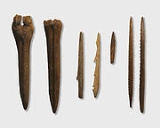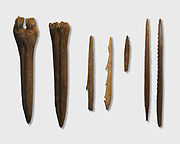
Kunda culture
Encyclopedia

Swiderian culture
Swiderian culture, also published in English literature as Sviderian and Swederian, is the name of Final Palaeolithic cultural complexes in Poland and the surrounding areas. The type-site is Świdry Wielkie, in Otwock. The Swiderian is recognized as a distinctive culture that developed on the sand...
is a mesolithic
Mesolithic
The Mesolithic is an archaeological concept used to refer to certain groups of archaeological cultures defined as falling between the Paleolithic and the Neolithic....
hunter-gatherer
Hunter-gatherer
A hunter-gatherer or forage society is one in which most or all food is obtained from wild plants and animals, in contrast to agricultural societies which rely mainly on domesticated species. Hunting and gathering was the ancestral subsistence mode of Homo, and all modern humans were...
communities of the Baltic
Baltic region
The terms Baltic region, Baltic Rim countries, and Baltic Rim refer to slightly different combinations of countries in the general area surrounding the Baltic Sea.- Etymology :...
forest zone extending eastwards through Latvia
Latvia
Latvia , officially the Republic of Latvia , is a country in the Baltic region of Northern Europe. It is bordered to the north by Estonia , to the south by Lithuania , to the east by the Russian Federation , to the southeast by Belarus and shares maritime borders to the west with Sweden...
into northern Russia
Russia
Russia or , officially known as both Russia and the Russian Federation , is a country in northern Eurasia. It is a federal semi-presidential republic, comprising 83 federal subjects...
dating to the period 8000–5000 BC by calibrated radiocarbon dating
Radiocarbon dating
Radiocarbon dating is a radiometric dating method that uses the naturally occurring radioisotope carbon-14 to estimate the age of carbon-bearing materials up to about 58,000 to 62,000 years. Raw, i.e. uncalibrated, radiocarbon ages are usually reported in radiocarbon years "Before Present" ,...
. It is named after the Estonia
Estonia
Estonia , officially the Republic of Estonia , is a state in the Baltic region of Northern Europe. It is bordered to the north by the Gulf of Finland, to the west by the Baltic Sea, to the south by Latvia , and to the east by Lake Peipsi and the Russian Federation . Across the Baltic Sea lies...
n town of Kunda, about 110 kilometres (68.4 mi) east of Tallinn
Tallinn
Tallinn is the capital and largest city of Estonia. It occupies an area of with a population of 414,940. It is situated on the northern coast of the country, on the banks of the Gulf of Finland, south of Helsinki, east of Stockholm and west of Saint Petersburg. Tallinn's Old Town is in the list...
along the Gulf of Finland
Gulf of Finland
The Gulf of Finland is the easternmost arm of the Baltic Sea. It extends between Finland and Estonia all the way to Saint Petersburg in Russia, where the river Neva drains into it. Other major cities around the gulf include Helsinki and Tallinn...
, near where the first extensively studied settlement was discovered on Lammasmäe Hill and in the surrounding peat bog
Bog
A bog, quagmire or mire is a wetland that accumulates acidic peat, a deposit of dead plant material—often mosses or, in Arctic climates, lichens....
.
Most Kunda settlements are located near the edge of the forests beside rivers, lakes, or marshes. Elk
Moose
The moose or Eurasian elk is the largest extant species in the deer family. Moose are distinguished by the palmate antlers of the males; other members of the family have antlers with a dendritic configuration...
were extensively hunted, perhaps helped by trained domestic hunting-dogs. On the coast seal hunting is represented. Pike and other fish were taken from the rivers. There is a rich bone and antler industry, especially in relation to fishing gear. Tools were decorated with simple geometric designs, lacking the complexity of the contemporary Maglemosian Culture
Maglemosian culture
Maglemosian is the name given to a culture of the early Mesolithic period in Northern Europe. In Scandinavia, the culture is succeeded by the Kongemose culture....
communities to the southwest.
The Kunda Culture is succeeded by the Narva culture
Narva culture
Narva culture or eastern Baltic was a European Neolithic archaeological culture found in present-day Estonia, Latvia, Lithuania, Kaliningrad Oblast , and adjacent portions of Poland and Russia. A successor of the Mesolithic Kunda culture, Narva culture continued up to the start of the Bronze Age....
who use pottery and show some traces of food production. The oldest known Kunda culture settlement in Estonia is Pulli settlement
Pulli settlement
Pulli settlement, located on the right bank of the Pärnu River, is the oldest known human settlement in Estonia. It is located two kilometers from the town of Sindi, which is 14 kilometers from Pärnu...
.
Origin of culture
The Kunda culture appears to have undergone a transition from the Palaeolithic Swiderian cultureSwiderian culture
Swiderian culture, also published in English literature as Sviderian and Swederian, is the name of Final Palaeolithic cultural complexes in Poland and the surrounding areas. The type-site is Świdry Wielkie, in Otwock. The Swiderian is recognized as a distinctive culture that developed on the sand...
located previously over much of the same range. One such transition settlement, Pasieniai 1C in Lithuania
Lithuania
Lithuania , officially the Republic of Lithuania is a country in Northern Europe, the biggest of the three Baltic states. It is situated along the southeastern shore of the Baltic Sea, whereby to the west lie Sweden and Denmark...
, features stone tools of both Late Swiderian and early Kunda. One shape manufactured in both cultures is the retouched tanged point. The final Swiderian is dated 7800-7600 BC by calibrated radiocarbon dating, which is in the Preboreal
Boreal (period)
In paleoclimatology of the Holocene, the Boreal was the first of the Blytt-Sernander sequence of north European climatic phases that were originally based on the study of Danish peat bogs, named for Axel Blytt and Rutger Sernander, who first established the sequence. In peat bog sediments, the...
period, at the end of which time with no gap the early Kunda begins. Evidently the descendants of the Swiderians were the first to settle Estonia when it became habitable. Other post-Swiderian groups extended as far east as the Ural mountains
Ural Mountains
The Ural Mountains , or simply the Urals, are a mountain range that runs approximately from north to south through western Russia, from the coast of the Arctic Ocean to the Ural River and northwestern Kazakhstan. Their eastern side is usually considered the natural boundary between Europe and Asia...
.
Locations of sites
- Kunda
- LugaLugaLuga is a town and the administrative center of Luzhsky District of Leningrad Oblast, Russia, located on the Luga River south of St. Petersburg. Population:...
- Pasieniai, LithuaniaLithuaniaLithuania , officially the Republic of Lithuania is a country in Northern Europe, the biggest of the three Baltic states. It is situated along the southeastern shore of the Baltic Sea, whereby to the west lie Sweden and Denmark...
- PulliPulli settlementPulli settlement, located on the right bank of the Pärnu River, is the oldest known human settlement in Estonia. It is located two kilometers from the town of Sindi, which is 14 kilometers from Pärnu...
- Ristola, FinlandFinlandFinland , officially the Republic of Finland, is a Nordic country situated in the Fennoscandian region of Northern Europe. It is bordered by Sweden in the west, Norway in the north and Russia in the east, while Estonia lies to its south across the Gulf of Finland.Around 5.4 million people reside...
- VelizhVelizhVelizh is a town and the administrative center of Velizhsky District of Smolensk Oblast, Russia, situated on the bank of the Western Dvina, from Smolensk. Population:...
- Zvejnieki, LatviaLatviaLatvia , officially the Republic of Latvia , is a country in the Baltic region of Northern Europe. It is bordered to the north by Estonia , to the south by Lithuania , to the east by the Russian Federation , to the southeast by Belarus and shares maritime borders to the west with Sweden...

